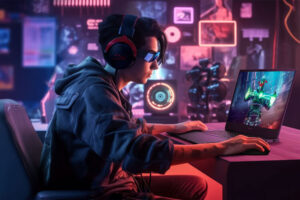Revolutionizing Gameplay: The Future of Virtual Reality in Gaming

Virtual reality (VR) has taken the gaming world by storm, offering an immersive experience that transcends traditional boundaries. The evolution of VR technology has paved the way for a revolution in gameplay, introducing players to a new dimension of interactive entertainment. As VR headsets become more accessible and sophisticated, the gaming industry is poised for a transformative shift.
In the early days of VR, enthusiasts faced clunky hardware and limited game options, but advancements have propelled the medium into mainstream appeal. The appeal lies not only in the visual spectacle but also in the sensory engagement that VR brings. From the adrenaline rush of a high-stakes virtual battle to the serene exploration of fantastical landscapes, VR gaming offers an unprecedented level of escapism. This rise in popularity prompts an exploration of the factors driving the surge in virtual reality gaming.
Breaking Barriers with Immersive Storytelling

One of the most compelling aspects of VR in gaming is its potential to revolutionize storytelling. Traditional games often rely on cutscenes or scripted events to convey narratives, but VR enables players to be active participants in the unfolding story. Imagine stepping into the shoes of the protagonist, making crucial decisions that shape the plot, and feeling the emotional impact of the narrative in a visceral way. This shift from passive to active storytelling has the power to redefine the gaming experience, making it more personal and engaging.
As VR developers focus on creating rich, immersive worlds, storytelling takes center stage. Games like “Half-Life: Alyx” and “Resident Evil 7: Biohazard” showcase the narrative possibilities of VR, blending gripping stories with interactive gameplay. The future holds promise for even more sophisticated narratives, where players can influence outcomes through their choices and actions, blurring the line between reality and virtual fiction.
Enhancing Realism Through Haptic Feedback
While stunning visuals contribute to the immersive nature of VR gaming, the integration of haptic feedback technology takes realism to a whole new level. Haptic feedback allows players to feel the virtual environment through tactile sensations, adding a layer of immersion beyond what traditional controllers can provide. From the subtle vibrations of footsteps to the powerful recoil of a virtual gun, haptic feedback enhances the gaming experience by engaging the sense of touch.
Developments in haptic technology have led to more refined and responsive feedback systems. VR controllers now simulate the texture of objects, the impact of virtual collisions, and even the resistance of virtual surfaces. This not only heightens the overall sense of presence but also opens up new possibilities for gameplay mechanics. As haptic technology continues to advance, players can expect a more nuanced and realistic connection to the virtual worlds they inhabit. In the realm of digital experiences, finding the best web design company in Chicago becomes crucial for businesses looking to establish an impactful online presence.
Social Interaction in the Virtual Realm
Gaming has always been a social activity, and VR introduces a paradigm shift in how players connect with each other. The traditional multiplayer experience is elevated as VR allows users to interact in a shared virtual space. Whether collaborating on a mission or competing in a virtual arena, the social aspect of gaming is redefined through VR.
Platforms like VRChat and Rec Room demonstrate the potential of social VR, enabling users to communicate through avatars and engage in a variety of activities. Virtual gatherings, live events, and shared adventures become more than just gaming experiences; they become social events where friends, and even strangers, can connect on a deeper level. The social dimension of VR not only enhances gameplay but also fosters a sense of community in the digital realm. Imagine attending a virtual party where, in addition to the lively conversations and shared activities, you can also savor the immersive atmosphere with blood orange flavoring infused in the virtual refreshments, adding an extra layer of sensory delight to the experience.
Overcoming Challenges and Expanding Accessibility
Despite the promising trajectory of VR in gaming, challenges remain, particularly in terms of accessibility and affordability. High-quality VR hardware often comes with a hefty price tag, limiting widespread adoption. However, ongoing efforts by developers and manufacturers aim to overcome these barriers, making VR more accessible to a broader audience.
Advancements in standalone VR headsets, like the Oculus Quest series, offer a wireless and more affordable entry point into virtual reality. Additionally, cloud gaming services may further democratize access to VR experiences, allowing users to stream content without the need for powerful hardware. As these barriers diminish, the potential for VR to become a ubiquitous and integral part of the gaming landscape becomes increasingly feasible. In the healthcare sector, this technological progress extends to innovative solutions like mobile IV nurses, leveraging VR to enhance training simulations and patient care experiences.
Pushing the Boundaries: AI Integration in VR Gaming
A key frontier in the evolution of virtual reality gaming lies in the seamless integration of artificial intelligence (AI). As AI technology continues to advance, its incorporation into VR experiences has the potential to revolutionize not only gameplay mechanics but also the very nature of in-game characters. Imagine interacting with NPCs (non-playable characters) that learn and adapt to your playstyle, creating a dynamic and personalized gaming experience. A key frontier in the evolution of virtual reality gaming lies in the seamless integration of artificial intelligence (AI). As AI technology continues to advance, its incorporation into VR experiences has the potential to revolutionize not only gameplay mechanics but also the very nature of in-game characters. Ergonomic keyboards play a vital role in enhancing the user’s interaction with these AI-driven virtual worlds, ensuring a comfortable and efficient gaming experience. Imagine interacting with NPCs (non-playable characters) that learn and adapt to your playstyle, creating a dynamic and personalized gaming experience.
AI-driven narratives could dynamically respond to player choices, offering branching storylines that evolve based on individual decisions. This not only enhances replayability but also adds a layer of unpredictability, ensuring that each gaming session feels unique. Moreover, AI-controlled characters could become more sophisticated, offering realistic companions or adversaries that adapt to the player’s strategies, challenging them in ways previously thought impossible.
The Convergence of Virtual and Augmented Reality
While virtual reality immerses players in entirely digital environments, augmented reality (AR) overlays digital elements in the real world. The convergence of these two realities presents an exciting avenue for the future of VR gaming. Imagine exploring a physical space while donning a VR headset that transforms your surroundings into a fantastical landscape. AR elements could seamlessly blend with the real world, creating a mixed-reality gaming experience that transcends the limitations of traditional gameplay. Moreover, for those interested in bringing these innovative technologies to life,website development in Green Bay is at the forefront, offering tailored solutions to enhance user experiences and push the boundaries of virtual and augmented reality integration.
This fusion of virtual and augmented reality opens the door to innovative multiplayer experiences where players interact with both digital and physical elements. Cooperative quests could lead players to discover hidden AR objects in their surroundings, fostering a deeper connection between the virtual and real worlds. The possibilities are vast, from virtual treasure hunts in your backyard to collaborative adventures that bridge the gap between the digital and physical realms. Additionally, ensuring a pleasant journey, even in the real world, becomes paramount with services like car AC replacement in Toronto readily available.
The Evolution of VR Sports and Fitness

Virtual reality gaming is not limited to fantastical worlds and fictional narratives; it has the potential to revolutionize sports and fitness experiences. Men’s patriotic t-shirts can be a part of this transformation, creating a sense of national pride as users engage in immersive training environments, allowing them to hone their skills in virtual replicas of real-world stadiums or training facilities. From soccer to boxing, VR sports simulations offer a unique blend of physical activity and digital engagement.
Fitness-focused VR experiences, such as Beat Saber and Supernatural, have already gained popularity by combining energetic workouts with captivating gameplay. As VR hardware becomes more lightweight and comfortable, we can expect a surge in fitness applications that make exercise an enjoyable and immersive activity. Virtual reality has the power to transform living rooms into personal gyms, offering a new frontier for health-conscious gamers.
Environmental Impact and Sustainable VR Gaming
As the gaming industry continues to grow, so does its environmental impact. Virtual reality, with its high-performance hardware requirements, raises concerns about energy consumption and electronic waste. However, the future of VR gaming may see a shift towards sustainability. Efforts to develop energy-efficient hardware and eco-friendly manufacturing processes could alleviate some of these concerns. That’s why great smart home tech add-ons would help with this, so you can look for some of the suitable properties that already have these add-ons in them at a mortgage company in Raleigh NC.
Moreover, VR experiences centered around environmental awareness and conservation could contribute to positive change. Imagine a VR game that educates players about ecosystems or challenges them to solve environmental puzzles. By combining entertainment with a focus on ecological issues, VR gaming could become a powerful tool for raising awareness and fostering a sense of responsibility towards the planet.
Mind-Body Connectivity: The Next Frontier in VR Interface
Advancements in neurotechnology and brain-computer interfaces open up new possibilities for mind-body connectivity in virtual reality gaming. Imagine controlling in-game actions not only with hand gestures but also with your thoughts. Brain-computer interfaces could enable a direct link between the player’s neural activity and the virtual environment, creating a more intuitive and immersive gaming experience. An internet service provider that manages IT services in San Antonio provides its clients with excellent internet to explore and try out such opportunities.
This level of mind-body connectivity has implications beyond just gameplay. VR therapy applications could leverage this technology to provide immersive therapeutic experiences for mental health treatment. The potential to enhance cognitive abilities through neurofeedback in virtual environments adds another layer to the transformative power of VR. As these interfaces become more refined and accessible, the boundaries between the mind and virtual space could blur, opening up unprecedented avenues for exploration.
Global Collaboration in Virtual Worlds
The rise of virtual reality in gaming brings with it the potential for global collaboration on an unprecedented scale. Virtual worlds could become hubs for creativity, where developers, artists, and players from different corners of the world come together to build, explore, and share experiences. Platforms supporting user-generated content could evolve into vast digital landscapes shaped by the collective imagination of a global community. In order to participate in these changes as well as experience the true possibilities of virtual games you will need a lot of space so consider some of the beautiful houses in Boca Falls that are very luxurious and spacious.
Collaborative game development projects, virtual art exhibitions, and cross-cultural experiences could flourish in these shared virtual spaces. The ability to communicate in real-time with individuals from diverse backgrounds enhances not only the gaming experience but also fosters a sense of global connection. Virtual reality has the power to break down geographical barriers, creating a truly interconnected gaming ecosystem.
Ethical Considerations and Virtual Morality
As virtual reality becomes more integrated into everyday life, ethical considerations surrounding VR experiences come to the forefront. Questions about the impact of immersive virtual environments on mental health, the boundaries of acceptable in-game behavior, and the consequences of realistic simulations must be addressed. The ethical framework for virtual reality gaming needs to evolve alongside the technology to ensure a positive and responsible user experience. You can find some of the online courses that contain communities to consider and improve these excellent virtual gaming opportunities.
Developers may need to implement features that promote responsible gaming and consider the psychological well-being of users. Ethical guidelines for VR content creation and consumption may become essential to prevent potential harm. Striking a balance between the freedom of expression in virtual worlds and the ethical considerations of user safety will be a crucial aspect of shaping the future of virtual reality gaming.
Empowering Education Through VR Learning Environments
The potential of virtual reality extends beyond entertainment, reaching into the realm of education. VR learning environments have the capacity to revolutionize traditional educational methods by providing immersive and interactive experiences. Imagine students exploring ancient civilizations, conducting virtual science experiments, or collaborating with classmates in a shared virtual space.
VR can cater to diverse learning styles, offering a more engaging and memorable educational experience. From language learning to historical reenactments, virtual reality provides a platform for experiential learning that goes beyond the limitations of textbooks and traditional classrooms. As VR hardware becomes more affordable and educational content continues to expand, we can anticipate a significant shift in how knowledge is acquired and assimilated.
The Democratization of VR Content Creation

The democratization of content creation is a prevailing trend across various digital mediums, and virtual reality is no exception. As tools and platforms become more accessible, a new wave of VR content creators emerges. From indie developers crafting unique gaming experiences to individuals creating immersive storytelling in virtual spaces, the landscape of VR content is diversifying.
User-generated content platforms and VR creation tools empower individuals with the ability to shape their virtual experiences. This shift not only enriches the variety of VR content available but also encourages innovation and experimentation. Virtual reality becomes a canvas for creative expression, where anyone with a vision can contribute to the ever-expanding tapestry of immersive digital worlds.
Closing Thoughts: Navigating the Uncharted Future of VR Gaming
In navigating the uncharted future of virtual reality gaming, one thing remains certain—the landscape is vast, dynamic, and filled with possibilities. From the convergence of virtual and augmented reality to the integration of AI and mind-body interfaces, the trajectory of VR gaming is marked by constant innovation.
As technology continues to evolve and barriers to entry diminish, the democratization of VR experiences will usher in an era where the virtual and real worlds seamlessly coexist. The future of virtual reality gaming is not just a revolution in gameplay; it is a transformative journey into unexplored territories, where the boundaries of imagination are continually pushed, and the only limit is the extent of human creativity.




